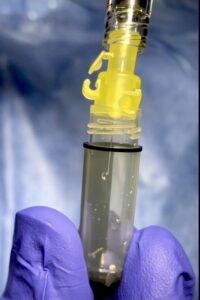Researchers headed by a team at Stanford University have mapped almost 6,000 proteins from different cell types within the eye by analyzing tiny drops of eye fluid that are routinely removed during surgery. The team developed an approach, called TEMPO ((tracing expression of multiple protein origins), that integrates microvolume liquid-biopsy proteomics, single-cell transcriptomics, and AI, to generate a “proteomic clock” that can predict a healthy person’s age based on their protein profile.
The clock revealed that diseases such as diabetic retinopathy and uveitis cause accelerated aging within specific cell types. Surprisingly, the researchers also detected proteins associated with Parkinson’s disease (PD) within eye fluid, which they say could offer a pathway to earlier Parkinson’s diagnoses.
“What’s amazing about the eye is we can look inside and see diseases happening in real time,” Vinit Mahajan, MD, PhD, surgeon and professor of ophthalmology at Stanford University. “Our primary focus was to connect those anatomical changes to what’s happening at the molecular level inside the eyes of our patients.” Mahajan is senior author of the team’s published paper in Cell, titled “Liquid-biopsy proteomics combined with AI identifies cellular drivers of eye aging and disease in vivo.” In their report they concluded, “Application of TEMPO could be transformative toward identifying cellular mechanisms, enhancing diagnosis, optimizing clinical trials, and determining the interplay between aging and disease.”
The eye is a difficult organ to sample in living patients because, like the brain, it is non-regenerative, and taking a tissue biopsy would cause irreparable damage. As the authors noted, “In particular, cell-level analysis has been severely limited in non-regenerative organs and tissues, such as the brain and the retina, because direct biopsies would cause serious, irreversible functional damage.” An alternative method is to use liquid biopsies, which are samples of fluid taken from near the cells or tissues of interest. The approach does have limitations, however. While liquid biopsies can provide a snapshot of what proteins are present in the region of interest, to date they have been limited in their ability to measure large numbers of proteins within the small volumes of fluid. They are also unable to provide information on which cells produced which proteins, which is important for diagnosing and treating diseases. “… current analyses cannot resolve proteins at refined cellular resolution,” the team continued.
The multi-modal TEMPOapproach developed by Mahajan and colleagues combines proteomics in cells acquired in microvolume liquid biopsies, with single-cell transcriptomics techniques, and AI, to addresses these limitations, and “… resulting in a powerful and minimally invasive tool to examine disease and aging mechanisms at the cell level in vivo,” they stated. To map protein production by different types of cells within the eye, the researchers applied the platform to characterize proteins in 120 liquid biopsies taken from the aqueous humor (AH) or vitreous humor (VH) of patients undergoing eye surgery. They identified 5,953 proteins—ten times the number of proteins previously characterized in similar studies, and were then able to trace each protein back to specific cell types.

The study also discovered evidence that immune cells are involved in later-stage DR, and found an increase in liver-derived proteins in the AH of DR patients. “TEMPO, as applied to AH liquid biopsies, has uncovered a role for specific immune cells and liver proteins in DR, which could change therapeutic strategies,” the scientists wrote. “To our knowledge, this is the first in vivo human molecular data demonstrating that immune cells, such as macrophages, are important molecular drivers of late-stage DR.” The liver proteins identified are known to be involved in inflammatory processes, and this, the team noted, raises the possibility that the liver may directly contribute to inflammation in DR pathology, “… indicating that systemic therapeutic intervention may be beneficial.”
The researchers in addition detected several proteins that are associated with Parkinson’s disease. These proteins are usually only identified post mortem, and current diagnostic methods aren’t capable of testing for them, which is one reason Parkinson’s diagnoses are so difficult. Screening for these markers in eye fluid could potentially enable earlier diagnosis of Parkinson’s disease and later therapeutic monitoring. “Neurodegenerative diseases, such as PD, often represent a diagnostic challenge and may not be definitively diagnosed without a postmortem examination,” they wrote. “Here, we show the potential of using AH liquid biopsies as a valuable tool for diagnostic and prognostic assessment of brain disease … These results redefine the PD phenotype in the retina at a molecular and cell level and highlight the potential of AH liquid biopsies as a valuable tool for diagnostic assessment or even molecular monitoring of PD therapies.”
The authors say that their collective results suggest that aging may be organ- or even cell-specific, which could yield advances in precision medicine and clinical trial design. “These findings demonstrate that our organs are aging at different rates,” said first author and ophthalmologist Julian Wolf, MD, at Stanford University. “The use of targeted anti-aging drugs could be the next step in preventative, precision medicine.”
Added Mahajan, “If we’re going to use molecular therapies, we should be characterizing the molecules in our patients. I think reclassifying patients based on their molecular patterns and which cells are being affected can really improve clinical trials, drug selection, and drug outcomes.”
Next, the researchers plan to characterize samples from a larger number of patients and a broader range of eye diseases. They also say that their method could be used to characterize other difficult-to-sample tissues. For example, liquid biopsies of cerebrospinal fluid could be used to study or diagnose the brain, synovial fluid could be used to study joints, and urine could be used to study the kidneys. In their paper the investigators concluded, “Our approach, which can be applied to other organ systems, has the potential to transform molecular diagnostics and prognostics while uncovering new cellular disease and aging mechanisms … TEMPO fills a critical gap in the ability to study human disease and aging at the molecular and cellular levels in living humans.”



